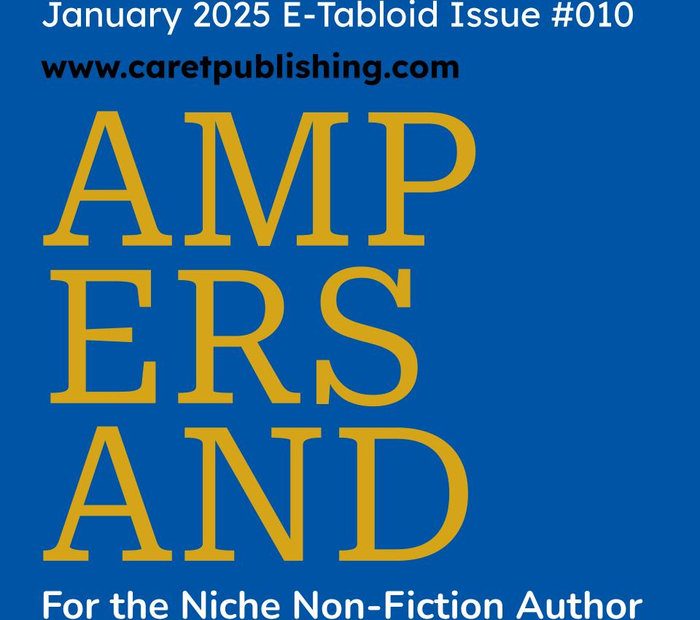One of the more critical duties of big and small presses is to forecast trends in nonfiction publishing for the upcoming year. Knowing the ins and outs of your industry is essential for expanding knowledge and gaining experience in running a publishing business. However, anticipating the direction the industry will take based on current realities is equally important and a natural part of annual planning.
At Caret Publishing, we acknowledge our duty to contribute to the future of publishing, even in our own small way. Here, we share a few bold and exciting projections in nonfiction publishing for 2025, which you can consider whether you’re a writer, distributor, marketer, or fellow publisher.
AMPERSAND E-TABLOID ISSUE #010

Rise of International Micro and Small Presses
As one of the global micro and small presses, Caret Publishing is optimistic that 2025 will allow us to strengthen our unique position in the market. We look forward to working on book deals with both new and semi-established authors from around the world.
The recent pandemic permanently altered the industry, leading some publishers, especially those tied to their locality, to close. However, it also allowed more mobile and adaptive publishers like us to emerge, offering a more tailored approach to both production and marketing, as well as higher royalties (as much as 50%!). These advantages are especially appealing to budding writers who feel overwhelmed by limited opportunities in their respective genres and categories. We’re more than happy to earn their trust and deliver on our promises.
Evergreen Niche Topics
With the rapid pace of content creation today—sometimes aided by automation—we anticipate an increase in books on evergreen niche topics in 2025. These topics, driven by experts in specialised fields that haven’t yet enjoyed widespread attention, will capture readers’ interest.
Examples of such “boring but essential” subjects might include regenerative agriculture, pet insurance, and electric vehicle services. While these areas may seem niche, their general principles are well-established and ripe for deeper exploration. If you’re a professional in such a sector, don’t be surprised to see books about your industry—and perhaps consider writing one yourself!
Sustainability Turns More Heads
Sustainability has been a growing focus in recent years, and this trend will remain significant in 2025. As climate change concerns continue to rise, consumers, corporations, and industries are increasingly seeking sustainable and environmentally conscious solutions.
In nonfiction publishing, we expect this theme to maintain its relevance, driving demand for books from voices in underrepresented regions. These voices often bring innovative perspectives to the global dialogue on sustainability, making them invaluable to the industry’s efforts to push the message further.
More Vanity Publishers
Since the launch of ChatGPT in late 2022, industries worldwide have been affected by its potential to reshape their landscapes. In publishing, this has created a double-edged sword: while AI can improve oversight in independent publishing houses, it also opens the door for opportunists who prioritise profit over quality and credibility.
This isn’t a criticism of reputable vanity publishers that are transparent about their pay-to-publish model. Instead, it’s a caution to aspiring writers to be wary of companies that disguise themselves as traditional publishers while demanding exorbitant fees upfront.
Harnessing AI in Publishing
Long before ChatGPT arrived, artificial intelligence was already making its mark in various industries. For example, those chatbots that assist you at midnight with your bank or airline queries? That’s AI in action.
Generative AI will only improve, and despite its dystopian undertones, it’s here to stay. In publishing, AI can be a valuable tool for enhancing tasks like proofreading or marketing analysis. For instance, Grammarly, which has used AI for over 15 years, offers an additional layer of editing for manuscripts. However, it’s vital to remember that technology should always support human creativity—not replace it.
Tactile Marketing Returns
As digital marketing becomes increasingly saturated, readers are seeking ways to disconnect and engage offline. This shift signals a growing pushback against the digital-only approach, creating an opportunity for tactile marketing strategies.
In 2025, expect to see more publishers and authors investing in physical, interactive ways to promote books. From in-person events to creatively designed mail campaigns, tactile marketing will offer readers a refreshing alternative to the digital noise.

Audiobooks Gain Traction
Audiobooks have been steadily growing in popularity and are poised to gain even more traction in 2025. With the ongoing success of podcasts, audiobooks appeal to unconventional readers who prefer listening over traditional reading.
Continuous advancements in audio production are making this format more accessible and engaging. We anticipate that both established companies and startups will work to unlock its untapped potential, taking audiobooks to new heights.
Conclusion
If you want to be a trailblazer in the industry, hit your targets, or stay ahead of the competition, mastering the ability to analyse and apply recent data is essential. This applies to publishers as much as it does to writers and marketers.
Predictions like these serve one primary purpose: preparation. And by making a yearly forecast for nonfiction publishing, we equip ourselves as a small press to be more ready. However, hey should be studied, updated, and, most importantly, never treated as absolute. After all, when has a meteorologist ever predicted the storm with perfect accuracy?
Caret Publishing is a small press and imprint of niche non-fiction books, including self-help and business books. Feel free to send us a book proposal if you have an idea for or have completed a book. Go to Submit Your Work for more details.
